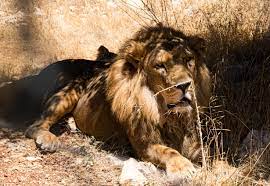The decline in African Lions has been pretty constant and totally devastating. Just 100 years ago, there were about 200,000 lions in Africa (some estimates suggest as many as 500,000 in 1950, and 200,000 as late as 1975.

Today the estimate of wild African lion populations is between 20,000 and 39,000 though most would say it was nearer the first. The serengeti has a lion population of about 3000, while Ruaha supports about 4000 and the Selous about 5000. The Limpopo has up to 2500 or a bit more, while the KAZA transfrontier park hosts perhaps another 1500. The Niassa National reserve also hosts about 1000 lions. There are a few other populations of slightly smaller size, such as the Tsavo lion population that numbers 600-700. As you can see, these numbers do not add up to 20,000, and while there are a good number more, which have smaller numbers of lions, these are unlikely to add up to more than 10,000
West African Lions (as well as central African lions) are essentially a relict population of the Asiatic Lion population and therefore need to be counted separately. There are thought to be about 400 of these. 90% live in one population, which means that the rest live in small enclaves.
The sad thing, is that most reserves are no where near their carrying capacity when it comes to lions. A recent study found, that of 175 parks and reserves that currently hold lions, only 1 in 3 have above 50% of the carrying capacity of the land in question.
As you can imagine, setting the bar at 50% carrying capacity is quite a low bar to clear.
The study found that it was a necessity to have a well funded national park service, to host one of this significant lion populations. However, this suggests while particular countries might be interested in having more lions within their borders, the land currently conserved, has plenty of space for a huge increase in population.
This suggests that relatively minor investments by charities, in well chosen reserves, could have a big impact on the long-term viability of the Africa lion.











